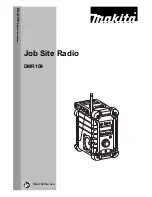
bunch of trees in the middle, (which would be a fatal problem for e.g. an 11 GHz microwave). 900 MHz
also penetrates buildings quite well, in an industrial environment full of steel and concrete it may be
the best choice. The signal gets “everywhere” thanks to many reflections, unfortunately there is bad
news attached to this - the reliability of high speed links in such environment is once again limited.
Otherwise, if network capacity is your main problem, then 900 MHz allows you to build the fastest and
most reliable links. The price you pay (compared to lower frequency bands) is really the price – more
repeaters and higher towers increase the initial cost. Long term reliable performance is the reward.
The three frequency bands discussed illustrate the simple basic rules – the higher the frequency, the
closer to LOS the signal has to travel. That limits the distance over the Earth's surface – there is no
other fundamental reason why shorter wavelengths could not be used for long distance communication.
On the other hand, the higher the frequency, the more reliable the radio link is. The conclusion is then
very simple – use the highest frequency band you can.
3.3. Signal budget
For every radio hop which may be used in the network, the signal level at the respective receiver input
has to be calculated and assessed against requirements. The fundamental requirements are two – the
data rate, which is dictated by total throughput and response times required by the application, and the
availability, which is again derived from the required reliability of the application. The data rate translates
to receiver sensitivity and the availability (e.g. 99,9 % percent of time) results in size of the fade margin.
The basic rule of signal budget says, that the difference between the signal level at the receiver input
and the guaranteed receiver sensitivity for the given data rate has to be greater than the fade margin
required:
RX signal [dBm] – RX sensitivity [dBm] >= Fade margin [dB]
To calculate the RX signal level, we follow the RF signal path:
TX
output
RX
input
feed line
loss
feed line
loss
path loss
TX
antenna
gain
RX
antenna
gain
+
+
Fig. 3.2: Signal path
example:
RX signal [dBm] =
dBm (TX output 1 W)
+30.0
+ TX output [dBm]
dB (20m cable RG-213 U, 400 MHz)
-2.5
- TX antenna feeder loss [dB]
dBi (half-wave dipole, 0 dBd)
+2.1
+TX antenna gain [dBi]
dB calculated from field measurement)
-125.0
- Path loss [dB]
dB (7-al Yagi antenna, 7.6 dBd)
+9.7
+ RX antenna gain [dBi]
31
© RACOM s.r.o. – RipEX Radio modem & Router
Network planning
Содержание RipEX 1.12.2
Страница 2: ......
Страница 172: ...RipEX Radio modem Router RACOM s r o 172 Safety environment licensing...
Страница 173: ...173 RACOM s r o RipEX Radio modem Router Safety environment licensing...
Страница 174: ...Fig 10 2 ATEX Certificate RipEX RipEX Radio modem Router RACOM s r o 174 Safety environment licensing...
Страница 175: ...175 RACOM s r o RipEX Radio modem Router Safety environment licensing...
Страница 176: ...RipEX Radio modem Router RACOM s r o 176 Safety environment licensing...
Страница 186: ...186...
Страница 187: ...Appendix C Revision History 187 RACOM s r o RipEX Radio modem Router Revision History...
















































